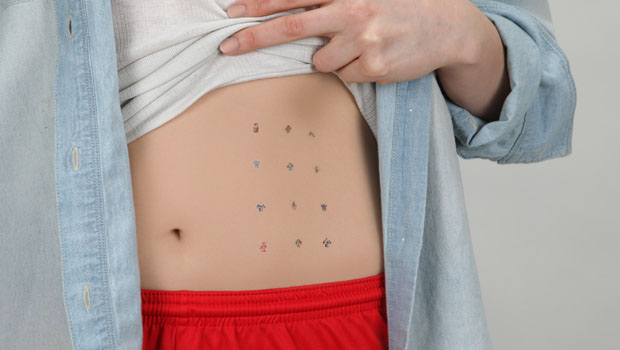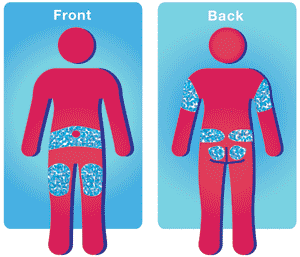A Tattoo Even Mom Will Love

![]() Among the things many parents tell their children not to do, getting a tattoo is right up there with drinking too much alcohol, riding motorcycles and using illegal drugs. But a new product called Tartoos – designed for multiple-daily injectors – may be quite acceptable, even sought after, by parents of diabetic children, and by adult insulin-injectors as well.
Among the things many parents tell their children not to do, getting a tattoo is right up there with drinking too much alcohol, riding motorcycles and using illegal drugs. But a new product called Tartoos – designed for multiple-daily injectors – may be quite acceptable, even sought after, by parents of diabetic children, and by adult insulin-injectors as well.
Tartoos (from ‘targeted tattoos’) are patent-pending temporary tattoos that offer a simple solution to a daily challenge: making sure to inject insulin in different places to avoid lipohypertrophy. In plain English, that’s a lump under the skin caused by a buildup of fat from too many insulin injections in the same place. It’s sometimes called ‘scar tissue,’ but that really isn’t the correct term, according to diabetes experts such as those at Joslin Diabetes Center.
Terminology aside, the reason to vary injection sites is simple: using the same site too often will cause slower insulin absorption (time to peak may be increased by as much as 30 percent), affect the accuracy of glucose readings, and possibly lead to insulin overdoses and hypoglycemia that may occur due to over correcting.
Learning how to give oneself a shot is a ritual as old as insulin-based self-treatment of diabetes. Even though insulin pumps offer an alternative to multiple daily injections, a majority of people with Type 1 diabetes continues to inject, and will do so tens of thousands of times during their lives. During training, doctors, nurses, and CDEs concentrate on teaching patients proper injection techniques, such as grasping a pinch of fat, and recognizing the proper angle at which to hold a syringe or insulin pen. They also discuss site selection with patients, usually telling the new injectors to picture a clock face on the abdominal area and to rotate the injection sites around the numbers on the imagined clock face.

possible injection sites, but most people
inject without help, limiting their
easy-to-reach choices to the front of the
body. Insulin is more quickly absorbed from
injections in the abdominal area, but you
should never inject within a 2-inch radius
of your navel.
The abdomen isn’t the only place where insulin injections may be done. There are as many as 403 places to inject, on the front and back of the body. They include the front and outside of the thighs, the upper and outer areas of the arms, the back just above the waist, and the buttocks. Insulin absorption rates vary according to the location; abdominal injections reach their peak most quickly. But for those who don’t want to involve anyone else in their injections (hard to do in the middle of a workday, or simply for one’s own privacy), the options are more limited. Most people will stick to easily accessible sites they can reach on the front of the body, which limits the number of available locations to around 180.
Tartoos takes the clock face idea in a new and fun direction by making it possible for people with diabetes, or the parents of children with diabetes, to ‘tattoo’ the abdomen and other injection areas with small images that are spaced one inch apart. Tartoos’s creators are aware that their largest customer base may be parents of kids with diabetes, so they have made the images fun for children, and designed them to call to mind the highly popular Transformer toys and cartoon images. Tartoos come on a 4.5 X 6.5 inch sheet with a removable clear plastic face and a paper backing that will pull away from the images when thoroughly wetted with a cloth for about 30 seconds. Adults usually use an entire sheet or 24 images at once. Petite adults and children can use fewer by trimming the sheet of Tartoos.
The recommended method for removing Tartoos is to use an anteseptic wipe just before an injection is administered. This has the advantage of preparing the site for sterile injection. In addition, with the Tartoo wiped away, the injection location is no longer marked by the Tartoo as available for another injection. Tartoos may also be easily removed with household rubbing alcohol, baby oil, or with a piece of transparent tape placed over the images on the skin.Tartoos are the creation of Rachael Jacques, a health educator from Plymouth, Minnesota, a suburb of Minneapolis. Growing up with a Type 1 sibling and attending classes for parents being initiated into the world of diabetes childcare gave her the idea. She describes both the product and her inspiration for it at length on her website. The site is worth a visit, if only to learn her story of growing up in a family she gracefully describes as “medically challenged.”
Jacques hopes to be ready to ship her product to customers by early May. Retail price is not yet final, but a month’s supply of Tartoos will cost less than $20. Jacques can be reached at rj@myvisualmedical.com. In addition to keeping up with her progress through her own site, watch InsulinNation.com for future updates.
Thanks for reading this Insulin Nation article. Want more Type 1 news? Subscribe here.
Have Type 2 diabetes or know someone who does? Try Type 2 Nation, our sister publication.